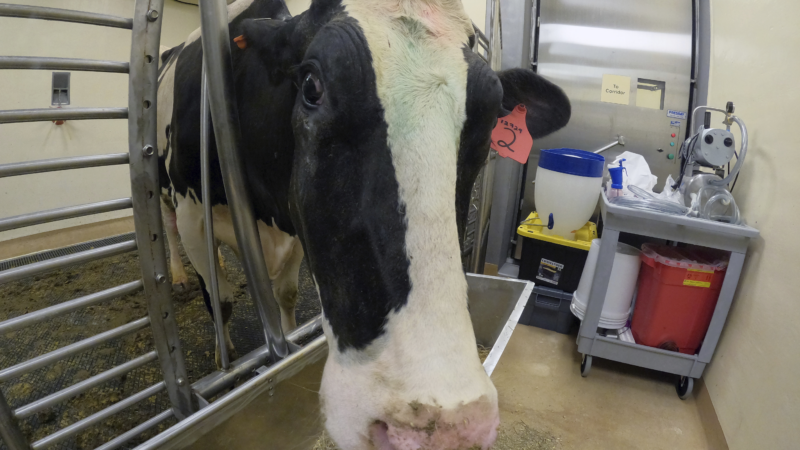After delay, CDC releases data signaling bird flu spread undetected in cows and people
The first study on the H5N1 bird flu outbreak from the Centers for Disease Control and Prevention to make it to publication under the Trump administration came out Thursday.
The journal released data suggesting some spillovers from dairy cattle into humans have gone undetected, including in states where dairy herds have not tested positive.
This comes after a freeze in external communications that interrupted the agency’s Morbidity and Mortality Weekly Report, or MMWR, a mainstay of public health communication. Publication on other topics resumed last week.
In the new study, researchers analyzed blood samples collected from 150 veterinarians who worked with cattle around the country and found that three of them had antibodies to the H5N1 virus, indicating recent infections. None recalled having any influenza-like symptoms or conjunctivitis. They also did not care for any cattle with known or suspected infections, although one did work with infected poultry.
The findings underscore the difficulty of detecting and controlling human infections based on whether or not a person seeks out medical care, says Gregory Gray, an infectious disease epidemiologist at the University of Texas Medical Branch in Galveston.
“If the circulating H5 viruses become more transmissible between humans, we are not going to be able to control transmission as the viruses will spread rapidly and often subclinically,” says Gray.
Previous CDC research that surveyed dairy workers found 7% had evidence of past infections, although only half reported symptoms. Work from Gray and his colleagues in Texas also indicates some cases in the dairy industry workforce are going undetected.
“It means our surveillance is inadequate,” says Lauren Sauer, a professor at the University of Nebraska Medical Center College of Public Health, “Any detection of asymptomatic or mild cases in this study just tells me we’re missing cases.”
One veterinarian in the study practiced in Georgia and South Carolina, states that had no known bird flu infections among cattle.
The new results from the CDC are far from a real-time reflection of what’s happening on the ground. The samples were collected in September – before the federal government had launched its national bulk milk testing program and the number of known human cases has since climbed to almost 70. However the new study calls for improved surveillance of cattle and dairy workers as well.
Just last week, a variant of H5N1 that had circulated in wild birds and poultry turned up in dairy cattle for the first time. The implications aren’t entirely clear yet. Some scientists worry this could spell additional trouble for efforts to stop the spread and eventually vaccinate dairy cattle. Researchers are also looking into whether the variant could be more deadly for humans.
The delay in publication of the MMWR under the Trump administration – and the broader freeze in communications from the CDC – amplified concerns among scientists and public health officials who are tracking the H5N1 outbreak. At least one additional study on H5N1 transmission related to household cats has not yet been published in the MMWR.
“We should never underestimate flu,” says Sauer. “If cases are occurring more frequently than detected in humans, we risk missing small changes that allow the virus to begin to spread much more easily in humans.
Tracking human infections in the dairy industry has been an ongoing challenge throughout the bird flu outbreak. Health agencies have limited authority to conduct disease surveillance on farms and workers are often reluctant to get tested.
Even though the new CDC research turned up a “low” number of past human infections,” it’s not actually clear “how many participants were truly exposed,” says Gray.
“No matter how we perform these serological assessments [antibody testing] we are likely to miss true infections,” he says. “I am not surprised with the low prevalence.”
A fire at a popular nightclub in India’s Goa state kills at least 25, officials say
At least 25 people, including tourists, were killed in a fire at a popular nightclub in India's Goa state, the state's chief minister said Sunday.
National parks fee-free calendar drops MLK Day, Juneteenth and adds Trump’s birthday
The Trump administration, which has railed against what it describes as "woke" policies, removed MLK Day and Juneteenth from next year's list of fare-exempt days for visitors at dozens of national parks.
Waymo will recall software after its self-driving cars passed stopped school buses
Waymo is issuing a software recall for its self-driving cars after reports the company's autonomous vehicles failed to stop for school buses.
7 deaths and hundreds of injuries are linked to faulty Abbott glucose monitors
About 3 million glucose monitoring sensors were potentially affected by a production error that caused incorrect low glucose readings.
‘The Abandons’ is a sudsy soap opera dressed up in spurs and a cowboy hat
On the surface it's a gorgeous, hardscrabble Western, awash in stark landscapes, grubby faces, bar fights and banditry. But scratch away the grime, and you expose the pure, glitzy soap opera beneath.
Sudanese paramilitary drone attack kills 50, including 33 children, doctor group says
Thursday's attack is the latest in the fighting between the paramilitary group, the Rapid Support Forces, also known as the RSF, and the Sudanese military, who have been at war for over two years.






